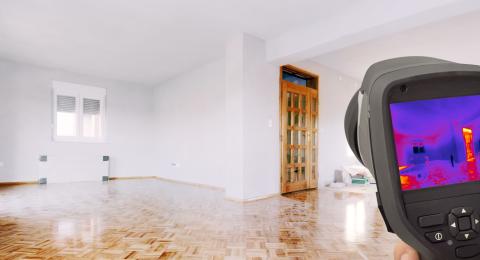
Heat-sensing technology allows your specially trained inspector to discover potential issues that would normally remain concealed.
Whether you need help targeting a concealed issue in your home, or want to make sure nothing is lurking hidden behind walls or ceilings before you purchase, thermal imaging can help detect issues with moisture, insulation, electrical hot spots and even wood-destroying organisms.
Thermal Imaging Considerations for a Property
If you notice cold spots in certain rooms (a sign of missing or wet insulation) or leaks from difficult-to-determine sources, thermal imaging may be a good option for you to sense behind walls and other surfaces to evaluate potential problems.
However, it’s important to understand thermal imaging does have its limitations. Just like general home inspections, thermal imaging can’t predict future issues. And it can’t completely eliminate the risk of concealed damage.
Thermal imaging can help pinpoint areas for further evaluation, like energy loss, moisture, electrical hot spots, flue leaks and even some pests.
How Thermal Imaging for Your Property Works
Infrared thermography uses camera-like imaging to capture invisible infrared electromagnetic waves. IR imagers detect surface temperatures and render visual images of thermal patterns. Using IR thermography, inspectors identify thermal patterns that may indicate air or water leakage, excessively hot electrical connections or insulation abnormalities.
A properly trained infrared thermographer will be knowledgeable of the object being viewed and know how to properly interpret images. Here at AmeriSpec, our inspectors that are trained in IR are qualified to use, interpret and report what the infrared camera can see that your eyes can’t.
5 Common Uses for Thermal Imaging
Using this non-invasive thermal imaging technology, your specially trained inspector may be able to detect or discover a whole host of potential issues and impacts that may be left unevaluated during a general home inspection.
- Moisture detection, including hidden plumbing leaks, roof leaks, wet insulation and other moisture entry places like foundation, basement or crawl space.
- Energy loss stemming from poor or missing insulation, damaged radiant heating systems, flue leaks, broken window seals and weak thermal barrier points like doors, windows, attics and more.
- Electrical hot spots like circuit breakers (included old or overloaded breaker boxes), electrical faults and overheated electrical components and equipment.
- Pest identification, especially termites and other wood-destroying organisms and mice.
- Reinspection of completed repairs to confirm the work of a contractor, technician or homeowner.
Find the Thermal Imaging Inspection Expert Near You
With more than 300 locations throughout the U.S., it’s easy to find a certified AmeriSpec inspector near you. Reach out today — we’re ready to answer any questions you have about thermal imaging inspections.
The AmeriSpec real estate inspection services may not be available everywhere. Please contact your local AmeriSpec office for more details. AmeriSpec services are provided by independently owned and operated franchises. Availability of services may vary depending on location.